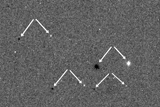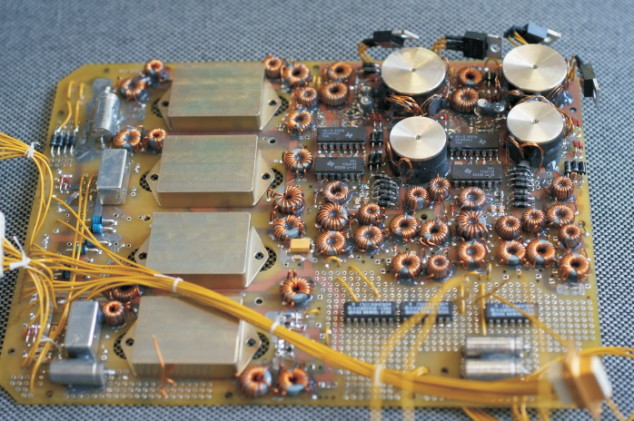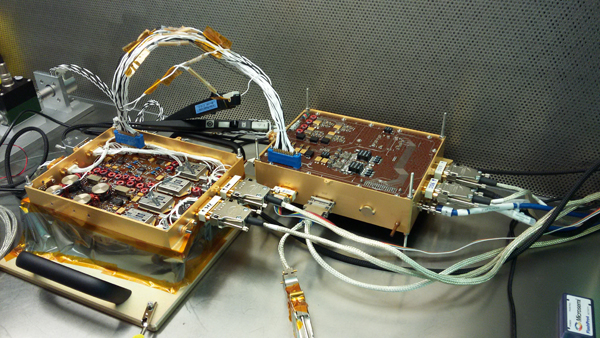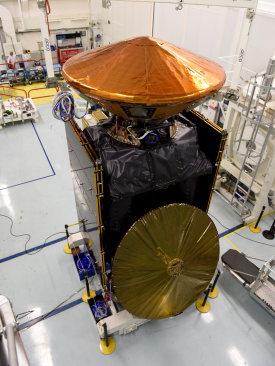
![]() The 2016 ExoMars Trace Gas Orbiter (TGO) is the first in a series of Mars missions to be undertaken jointly by the two space agencies, ESA and Roscosmos. A key goal of this mission is to gain a better understanding of methane and other atmospheric gases that are present in small concentrations (less than 1% of the atmosphere) but nevertheless could be evidence for possible biological or geological activity. One of the instruments of TGO is CaSSIS (Colour and Stereo Surface Imaging System). A high resolution Swiss camera (5 metres per pixel) capable of obtaining colour and stereo images over a wide swath. CaSSIS will provide the geological and dynamical context for sources or sinks of trace gases detected by two other instruments: NOMAD (Nadir and Occultation for Mars Discovery) and ACS (Atmospheric Chemistry Suite).
The 2016 ExoMars Trace Gas Orbiter (TGO) is the first in a series of Mars missions to be undertaken jointly by the two space agencies, ESA and Roscosmos. A key goal of this mission is to gain a better understanding of methane and other atmospheric gases that are present in small concentrations (less than 1% of the atmosphere) but nevertheless could be evidence for possible biological or geological activity. One of the instruments of TGO is CaSSIS (Colour and Stereo Surface Imaging System). A high resolution Swiss camera (5 metres per pixel) capable of obtaining colour and stereo images over a wide swath. CaSSIS will provide the geological and dynamical context for sources or sinks of trace gases detected by two other instruments: NOMAD (Nadir and Occultation for Mars Discovery) and ACS (Atmospheric Chemistry Suite).
![]() ExoMars was launched on a Russian Proton rocket from Baikonur on 14 March 2016, it has arrived at Mars in the last quarter of 2016. The Trace Gas Orbiter has reached successfully the Martian orbit in October 2016. Now its elliptical orbit takes it from 230–310 km above the surface to around 98 000 km every 4.2 days. The science operations phase of instruments is expected to begin at the earliest in May of 2017 (depending on the actual duration of the aerobraking phase) and last for a period of one Martian year. The science instruments on-board will determine the presence, quantity and potential sources and sinks of atmospheric methane, its precursor and product trace gases in the Martian atmosphere.
ExoMars was launched on a Russian Proton rocket from Baikonur on 14 March 2016, it has arrived at Mars in the last quarter of 2016. The Trace Gas Orbiter has reached successfully the Martian orbit in October 2016. Now its elliptical orbit takes it from 230–310 km above the surface to around 98 000 km every 4.2 days. The science operations phase of instruments is expected to begin at the earliest in May of 2017 (depending on the actual duration of the aerobraking phase) and last for a period of one Martian year. The science instruments on-board will determine the presence, quantity and potential sources and sinks of atmospheric methane, its precursor and product trace gases in the Martian atmosphere.
![]() CBK PAN has been responsible for design and manufacture of Power Converter Module for stereo camera CaSSIS.
CBK PAN has been responsible for design and manufacture of Power Converter Module for stereo camera CaSSIS.

![]() On 7 April 2016, TGO’s high-resolution CaSSIS camera was switched on for the first time, acquiring its first images of space. The view shows a randomly selected portion of the sky close to the southern celestial pole. This image is composed of two frames taken in slightly different directions by using the camera’s rotation mechanism. Subtracting one frame from the other reveals a number of equally offset positive and negative images of stars. This shows that the camera and its pointing mechanism are working well.
On 7 April 2016, TGO’s high-resolution CaSSIS camera was switched on for the first time, acquiring its first images of space. The view shows a randomly selected portion of the sky close to the southern celestial pole. This image is composed of two frames taken in slightly different directions by using the camera’s rotation mechanism. Subtracting one frame from the other reveals a number of equally offset positive and negative images of stars. This shows that the camera and its pointing mechanism are working well.
![]() “The initial switch-on went quite smoothly and so far things look good,” says Nicolas Thomas from the University of Bern in Switzerland, and camera principal investigator. “Although it was not designed to look at faint stars, these first images are very reassuring. Everything points to us being able to get good data at Mars.” Once at Mars, it will study surface features – including those that may be related to gas sources such as volcanoes.
“The initial switch-on went quite smoothly and so far things look good,” says Nicolas Thomas from the University of Bern in Switzerland, and camera principal investigator. “Although it was not designed to look at faint stars, these first images are very reassuring. Everything points to us being able to get good data at Mars.” Once at Mars, it will study surface features – including those that may be related to gas sources such as volcanoes.

![]() The Principal Investigator (PI) of CaSSIS camera is Prof.Nicolas Thomas from University of Bern, Switzerland. Participating countries are: Switzerland, Italy and Poland.
The Principal Investigator (PI) of CaSSIS camera is Prof.Nicolas Thomas from University of Bern, Switzerland. Participating countries are: Switzerland, Italy and Poland.
![]() In 2014 the CaSSIS contract between ESA and CBK PAN has been signed (first one in CBK PAN history in frame of PRODEX Programme). Then the EM model of PSU/CASSIS/TGO/ExoMars instrument has been delivered to Switzerland in middle of 2014. The final activities on EQM model of this block have been continued.
In 2014 the CaSSIS contract between ESA and CBK PAN has been signed (first one in CBK PAN history in frame of PRODEX Programme). Then the EM model of PSU/CASSIS/TGO/ExoMars instrument has been delivered to Switzerland in middle of 2014. The final activities on EQM model of this block have been continued.

![]() In 2015 the flight model of power converter module was finished in our laboratory and it was delivered in August to Switzerland. Then it was integrated with the other flight boards into the complete electronic box. The full integration of CaSSIS instrument and tests were perfored during autumn. TGO with its scientific payload underwent their final preparations at Thales Alenia Space in Cannes, France. In the end of December CaSSIS with TGO spacecraft was delivered to Baikonur cosmodrome to be integrated and mounted on Russian Proton rocket.
In 2015 the flight model of power converter module was finished in our laboratory and it was delivered in August to Switzerland. Then it was integrated with the other flight boards into the complete electronic box. The full integration of CaSSIS instrument and tests were perfored during autumn. TGO with its scientific payload underwent their final preparations at Thales Alenia Space in Cannes, France. In the end of December CaSSIS with TGO spacecraft was delivered to Baikonur cosmodrome to be integrated and mounted on Russian Proton rocket.

![]() The second module of the ExoMars 2016 mission is Schiaparelli - an entry, descent and landing demonstrator. Schiaparelli was to test key landing technologies for ESA's contributions to subsequent missions to Mars. Three days before reaching the atmosphere of Mars, the lander Schiaparelli separated from the Orbiter and it remained in hibernation mode in order to reduce its power consumption. Then it was activated on 19 October 2016, a few hours before entering the atmosphere of Mars, at an altitude of 122.5 km and a speed of approximately 21 000 km/h. An aerodynamic heatshield protected Schiaparelli from the severe heat flux and deceleration, so that at an altitude of about 11 km, when the parachure was deployed, it was travelling at around 1650 km/h. The liquid propulsion system has been activated to reduce the speed to about 15 km/h when it was 2m above the ground. At that moment the engines were to be switched off and the lander was to drop to the ground in the Meridani Planum region on Mars. Unfortunately, no signal indicating a successful landing was received from Schiaparelli module. The lander Schiaparelli, installed before launch at the top of the TGO, is shown on the right photo (Credit: ESA).
The second module of the ExoMars 2016 mission is Schiaparelli - an entry, descent and landing demonstrator. Schiaparelli was to test key landing technologies for ESA's contributions to subsequent missions to Mars. Three days before reaching the atmosphere of Mars, the lander Schiaparelli separated from the Orbiter and it remained in hibernation mode in order to reduce its power consumption. Then it was activated on 19 October 2016, a few hours before entering the atmosphere of Mars, at an altitude of 122.5 km and a speed of approximately 21 000 km/h. An aerodynamic heatshield protected Schiaparelli from the severe heat flux and deceleration, so that at an altitude of about 11 km, when the parachure was deployed, it was travelling at around 1650 km/h. The liquid propulsion system has been activated to reduce the speed to about 15 km/h when it was 2m above the ground. At that moment the engines were to be switched off and the lander was to drop to the ground in the Meridani Planum region on Mars. Unfortunately, no signal indicating a successful landing was received from Schiaparelli module. The lander Schiaparelli, installed before launch at the top of the TGO, is shown on the right photo (Credit: ESA).